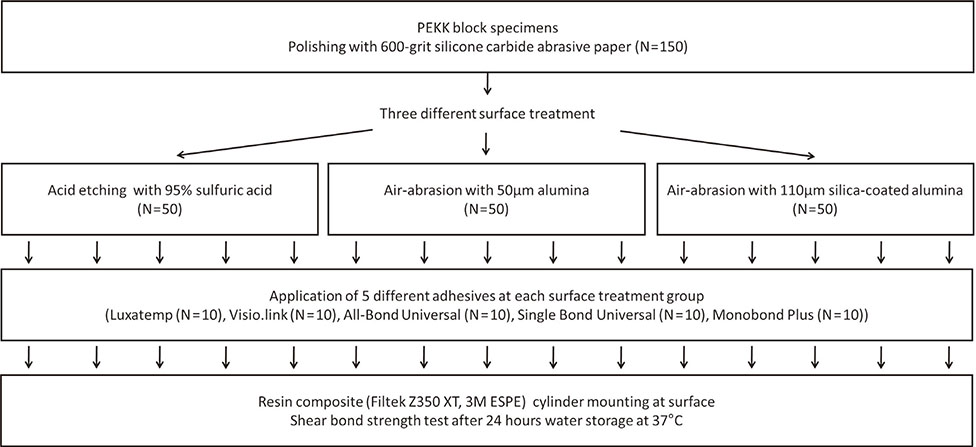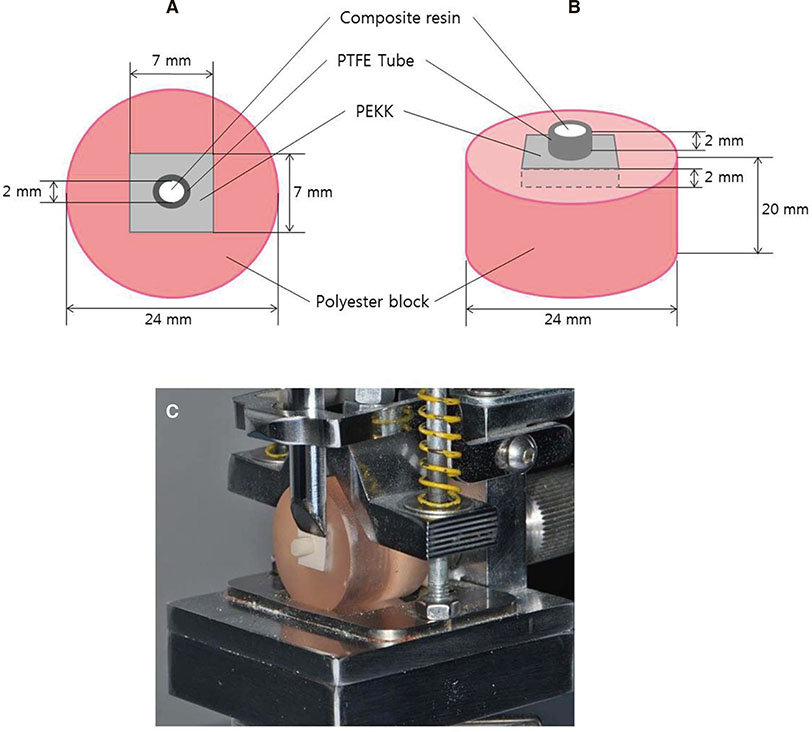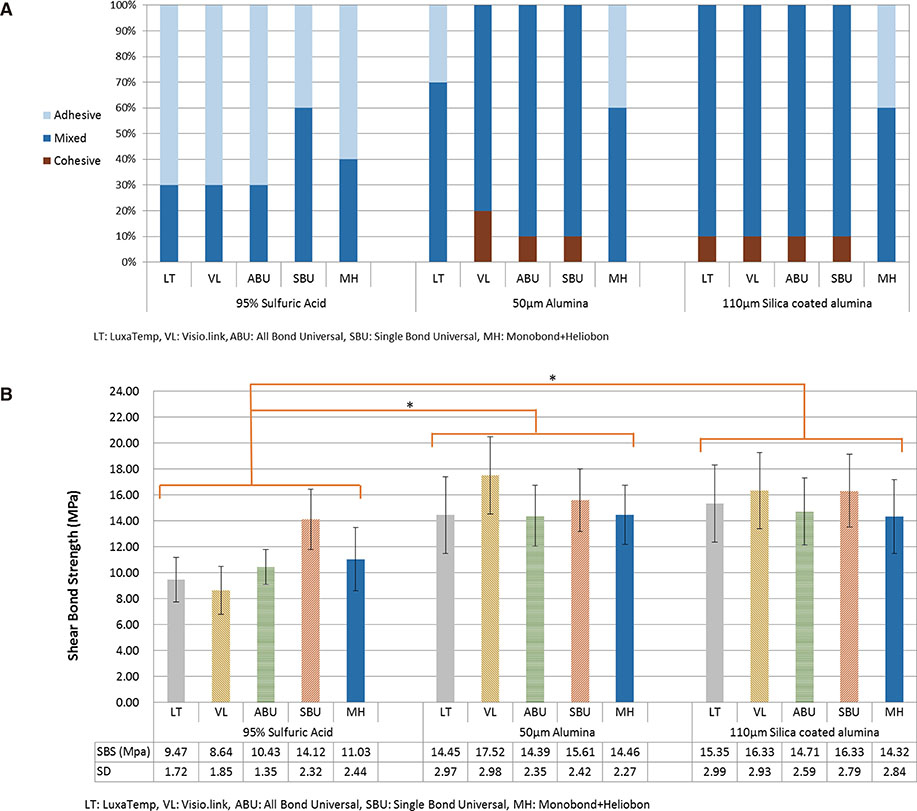J Adv Prosthodont.
2017 Oct;9(5):350-357. 10.4047/jap.2017.9.5.350.
Shear bond strength of composite resin to high performance polymer PEKK according to surface treatments and bonding materials
- Affiliations
-
- 1Department of Prosthodontics, Korea University Guro Hospital, Seoul, Republic of Korea. swshin@korea.ac.kr
- 2Graduate School of Clinical Dentistry, Korea University, Seoul, Republic of Korea.
- 3Department of Prosthodontics, Korea University Anam Hospital, Seoul, Republic of Korea.
- KMID: 2393220
- DOI: http://doi.org/10.4047/jap.2017.9.5.350
Abstract
- PURPOSE
The object of the present study was to evaluate the shear bonding strength of composite to PEKK by applying several methods of surface treatment associated with various bonding materials.
MATERIALS AND METHODS
One hundred and fifty PEKK specimens were assigned randomly to fifteen groups (n = 10) with the combination of three different surface treatments (95% sulfuric acid etching, airborne abrasion with 50 µm alumina, and airborne abrasion with 110 µm silica-coating alumina) and five different bonding materials (Luxatemp Glaze & Bond, Visio.link, All-Bond Universal, Single Bond Universal, and Monobond Plus with Heliobond). After surface treatment, surface roughness and contact angles were examined. Topography modifications after surface treatment were assessed with scanning electron microscopy. Resin composite was mounted on each specimen and then subjected to shear bond strength (SBS) test. SBS data were analyzed statistically using two-way ANOVA, and post-hoc Tukey's test (P<.05).
RESULTS
Regardless of bonding materials, mechanical surface treatment groups yielded significantly higher shear bonding strength values than chemical surface treatment groups. Unlike other adhesives, MDP and silane containing self-etching universal adhesive (Single Bond Universal) showed an effective shear bonding strength regardless of surface treatment method.
CONCLUSION
Mechanical surface treatment behaves better in terms of PEKK bonding. In addition, self-etching universal adhesive (Single Bond Universal) can be an alternative bonding material to PEKK irrespective of surface treatment method.
MeSH Terms
Figure
Reference
-
1. Stawarczyk B, Jordan P, Schmidlin PR, Roos M, Eichberger M, Gernet W, Keul C. PEEK surface treatment effects on tensile bond strength to veneering resins. J Prosthet Dent. 2014; 112:1278–1288.2. Fuhrmann G, Steiner M, Freitag-Wolf S, Kern M. Resin bonding to three types of polyaryletherketones (PAEKs)-durability and influence of surface conditioning. Dent Mater. 2014; 30:357–363.3. Schwitalla A, Müller WD. PEEK dental implants: a review of the literature. J Oral Implantol. 2013; 39:743–749.4. Kurtz SM, Devine JN. PEEK biomaterials in trauma, orthopedic, and spinal implants. Biomaterials. 2007; 28:4845–4869.5. Toth JM, Wang M, Estes BT, Scifert JL, Seim HB 3rd, Turner AS. Polyetheretherketone as a biomaterial for spinal applications. Biomaterials. 2006; 27:324–334.6. Tetelman ED, Babbush CA. A new transitional abutment for immediate aesthetics and function. Implant Dent. 2008; 17:51–58.7. Tannous F, Steiner M, Shahin R, Kern M. Retentive forces and fatigue resistance of thermoplastic resin clasps. Dent Mater. 2012; 28:273–278.8. Stawarczyk B, Keul C, Beuer F, Roos M, Schmidlin PR. Tensile bond strength of veneering resins to PEEK: impact of different adhesives. Dent Mater J. 2013; 32:441–448.9. Schmidlin PR, Stawarczyk B, Wieland M, Attin T, Hämmerle CH, Fischer J. Effect of different surface pre-treatments and luting materials on shear bond strength to PEEK. Dent Mater. 2010; 26:553–559.10. Hallmann L, Mehl A, Sereno N, Hammerle C. The improvement of adhesive properties of PEEK through pre-treatments. Appl Surface Sci. 2012; 258:7213–7218.11. Kern M, Lehmann F. Influence of surface conditioning on bonding to polyetheretherketon (PEEK). Dent Mater. 2012; 28:1280–1283.12. Kukiattrakoon B, Thammasitboon K. Optimal acidulated phosphate fluoride gel etching time for surface treatment of feldspathic porcelain: on shear bond strength to resin composite. Eur J Dent. 2012; 6:63–69.13. Güler AU, Yilmaz F, Yenisey M, Güler E, Ural C. Effect of acid etching time and a self-etching adhesive on the shear bond strength of composite resin to porcelain. J Adhes Dent. 2006; 8:21–25.14. Närhi TO, Tanner J, Ostela I, Narva K, Nohrström T, Tirri T, Vallittu PK. Anterior Z250 resin composite restorations: one-year evaluation of clinical performance. Clin Oral Investig. 2003; 7:241–243.15. Lohbauer U, von der, Frankenberger R, Krämer N, Petschelt A. Flexural fatigue behavior of resin composite dental restoratives. Dent Mater. 2003; 19:435–440.16. Shu S, Kobayashi H, Okubo M, Sabarudin A, Butsugan M, Umemura T. Chemical anchoring of lauryl methacrylatebased reversed phase monolith to 1/16″ o.d. polyetheretherketone tubing. J Chromatogr A. 2012; 1242:59–66.17. Stawarczyk B, Beuer F, Wimmer T, Jahn D, Sener B, Roos M, Schmidlin PR. Polyetheretherketone-a suitable material for fixed dental prostheses? J Biomed Mater Res B Appl Biomater. 2013; 101:1209–1216.18. Kadoma Y. Surface treatment agent for dental metals using a thiirane monomer and a phosphoric acid monomer. Dent Mater J. 2002; 21:156–169.19. Chen L, Suh BI, Brown D, Chen X. Bonding of primed zirconia ceramics: evidence of chemical bonding and improved bond strengths. Am J Dent. 2012; 25:103–108.20. Shin YJ, Shin Y, Yi YA, Kim J, Lee IB, Cho BH, Son HH, Seo DG. Evaluation of the shear bond strength of resin cement to Y-TZP ceramic after different surface treatments. Scanning. 2014; 36:479–486.21. Yi YA, Ahn JS, Park YJ, Jun SH, Lee IB, Cho BH, Son HH, Seo DG. The effect of sandblasting and different primers on shear bond strength between yttria-tetragonal zirconia polycrystal ceramic and a self-adhesive resin cement. Oper Dent. 2015; 40:63–71.22. Yoshida K, Tsuo Y, Atsuta M. Bonding of dual-cured resin cement to zirconia ceramic using phosphate acid ester monomer and zirconate coupler. J Biomed Mater Res B Appl Biomater. 2006; 77:28–33.23. Matinlinna JP, Vallittu PK. Bonding of resin composites to etchable ceramic surfaces - an insight review of the chemical aspects on surface conditioning. J Oral Rehabil. 2007; 34:622–630.24. Lung CY, Matinlinna JP. Aspects of silane coupling agents and surface conditioning in dentistry: an overview. Dent Mater. 2012; 28:467–477.
- Full Text Links
- Actions
-
Cited
- CITED
-
- Close
- Share
- Similar articles
-
- Effect of delayed time, surface treatment, and repair material on shear bond strength of repaired bis-acryl composite resin
- The shear bond strength of two adhesives bonded to composite resin and glass ionomer cement restorations
- Effect of surface pre-treatments and adhesive types on the shear bond strength between PEKK and Zirconia
- Effect of non-thermal plasma on the shear bond strength of resin cements to Polyetherketoneketone (PEKK)
- Shear Bond Strengths between Abrasion-Resistant Denture Teeth and Composite Resins







